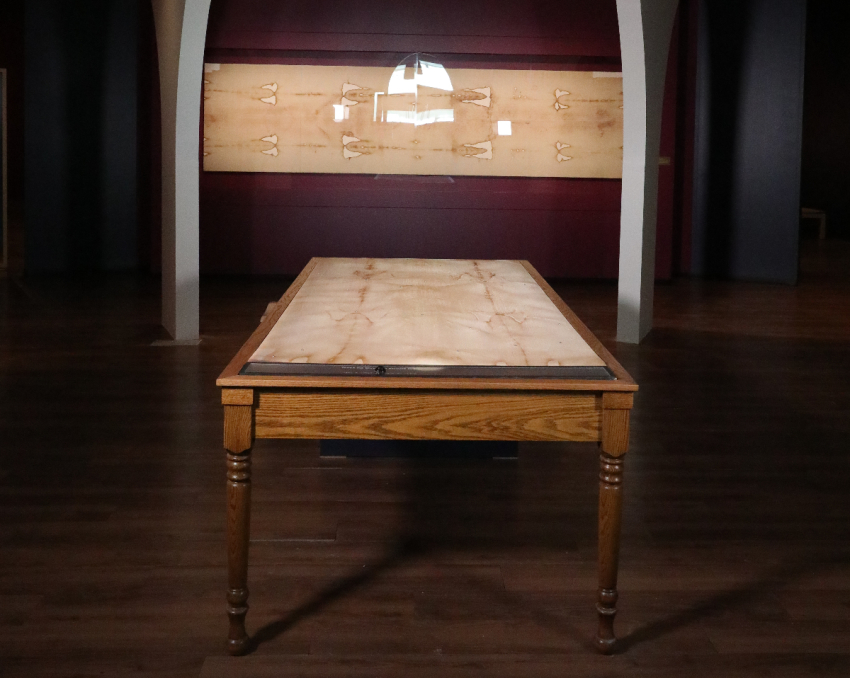New Museum of the Bible exhibit features Shroud of Turin: 'First viral image'

WASHINGTON — The Museum of the Bible has unveiled a Shroud of Turin exhibit that features a full-size replica of the cloth that some believe Jesus Christ was buried in and what one museum official referred to as “the first viral image.”
The fifth floor of the museum features an exhibit titled “The Mystery of Faith: The Shroud of Turin” through July 31. The exhibit includes a full-size replica of the Shroud of Turin, which, as a description of the exhibit explains, “bears a faint, yellowed image of a naked, crucified man and is believed by millions of Christians to be the burial cloth of Jesus of Nazareth.”
“Throughout this high-tech, interactive exhibit, visitors will explore how this cloth connects to the Gospels and has become one of the most immediately recognizable images of any figure from the Bible,” said Jeffrey Kloha, the chief curatorial officer at the Museum of the Bible, in a statement shared with The Christian Post. “Though the Shroud itself does not leave Turin, it has been featured on magazine covers, in documentaries, and even in Hollywood films. This exhibition explores the fascination and faith inspired by this cloth.”

According to Brian Hyland, curator of medieval manuscripts at the Museum of the Bible, “Two papal quotes frame the exhibition, which reveals how the Shroud mirrors the Gospels.” Specifically, “Pope John Paul II called the Shroud a mirror of the Gospel and Pope Benedict XVI called it an icon, suggesting that it is best viewed with the eyes of faith.”
Three days before the exhibit’s grand opening last weekend, museum leadership hosted a preview event for the media. Kloha discussed how the exhibit was “planned to open last year and then COVID happened.” He described the exhibit's delayed opening due to the coronavirus pandemic as “appropriate” because “the Shroud has always been connected to times of stress and danger and been a source of comfort all the way back to the Black Plague.”
Kloha characterized the Shroud as “the first viral image” because of its popularity throughout history as well as “the most famous image and familiar image of any person from the Bible.” As noted in the exhibit, “Since 1578, the Shroud has remained in Turin, a northern Italian city controlled by the House of Savoy, a high-ranking noble family.” Hyland likened the exhibit to a medieval cathedral before praising it for allowing visitors to have a more intimate experience with the Shroud than they would if they were to visit the actual Shroud in Turin.
“If you go to Turin to see the Shroud, you’re going to wait in line and you’re going to see it for maybe a minute to two minutes,” he said. “Here, you can get up close and you can really take a long, hard look at the image of … a man who has been brutally tortured, scourged, pierced, crucified and all of this should remind you of the Gospel stories, remind you of the stories of how Jesus suffered and died for love of us.”
As Hyland explained, “We’ve got sections dealing with the history of the Shroud and the science of the Shroud and scattered throughout this exhibit are eight different interactive devices.” Visitors will have “a chance to see how the Shroud aligned over the body” and flip through “a so-called magic book that tells the amazing somewhat strange story of how the Shroud first appeared.”
The “magic book” appears just like a regular book at first glance, but when visitors flip the pages, sensors activate animated videos that chronicle the events of the Shroud’s earliest days. The exhibit also contains a “selfie station so you can explore what it means when we talk about positive and negative images.” The “selfie station” enables visitors to take a picture of themselves and have both a “negative” and “positive” version of the image sent to their email account.
The exhibit details the Shroud’s role throughout history and includes a lesson about radiocarbon dating, which scientists used to help determine the age of the Shroud. After testing a small portion of the Shroud in the late 20th century, scientists determined that it dated to between AD 1260 and 1390.
Additionally, the exhibit outlines how the Shroud of Turin has changed hands over the years. While the Shroud remained in the hands of the Savoy family for over 400 years, it was willed to the papacy in 1983 upon the death of the former king of Italy, Umberto II. The exhibit also features an interactive timeline providing a detailed history of the Shroud.
Throughout history, the Shroud has survived multiple disasters. As indicated on the interactive timeline, “On December 4, 1532, a fire broke out at the church in Chambery [France], where the Shroud was kept. Intense flames surrounded the silver reliquary. The priest needed the help of a blacksmith to rescue the Shroud. He broke the box open, but not before a drop of molten silver burned through one corner of the folded cloth. Two years after the fire, the Poor Clare nuns patched the Shroud.”
“The triangular patches remained in place until a restoration in 2002 removed them to sustain the integrity of the cloth’s fibers,” the timeline continued. Visitors can obtain more information about the Shroud by touching sensors on an interactive version of the cloth, which highlights the significance of the burn marks and contains Bible verses related to the death and resurrection of Jesus Christ.
Ryan Foley is a reporter for The Christian Post. He can be reached at: ryan.foley@christianpost.com



























